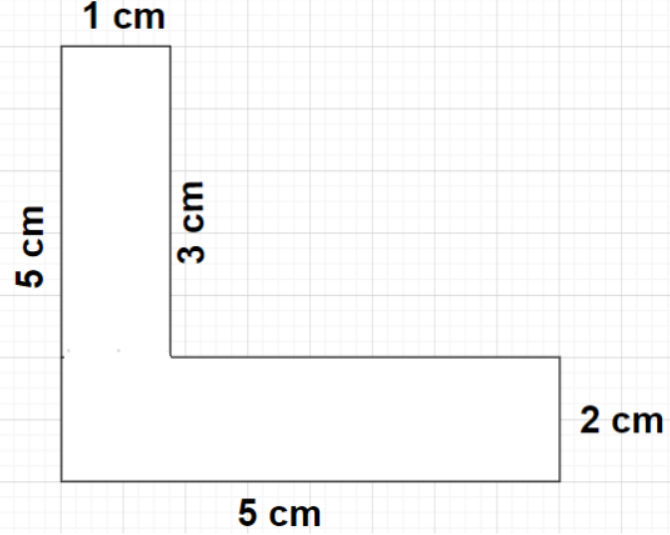
Find the area of the following figure.


Answer
601.2k+ views
Hint: Here, we will proceed by naming the points required in the given figure and we will join two points in order to convert the L-shaped given figure into two rectangles. Then, use the formula i.e., Area of rectangle = (Length of rectangle)$ \times $(Breadth of rectangle).
Complete step-by-step answer:
The given figure can be divided into two rectangles by joining the points A and E by a straight line after every point is named as shown in the second figure drawn.
Here, BG = 5 cm, EF = AG = 3 cm, AB = BG – AG = 5 – 3 = 2 cm, BC = AD = 5 cm, CD = 2 cm, GF = AE = 1 cm
As we know that area of any rectangle is given by
Area of rectangle = (Length of rectangle)$ \times $(Breadth of rectangle) $ \to (1)$
Using the formula given by equation (1), we can write
Area of rectangle ABCD = (BC)$ \times $(AB) = $5 \times 2 = 10{\text{ c}}{{\text{m}}^2}$
Again using the formula given by equation (1), we can write
Area of rectangle AEFG = (AE)$ \times $(AG) = $1 \times 3 = 3{\text{ c}}{{\text{m}}^2}$
Area of the complete figure = Area of rectangle ABCD + Area of rectangle AEFG
$ \Rightarrow $Area of the complete figure = 10+3 = 13 ${\text{c}}{{\text{m}}^2}$
Therefore, the area of the given figure is 13 sq. centimetres.
Note: In this particular problem, instead of joining points A and E we can also draw a line segment from point E to the line BC such that this line segment is perpendicular to line BC and name that meeting point as H. This will also result in dividing the given L-shaped figure into two rectangles i.e., rectangle HCDE and rectangle GBHF.
Complete step-by-step answer:
The given figure can be divided into two rectangles by joining the points A and E by a straight line after every point is named as shown in the second figure drawn.
Here, BG = 5 cm, EF = AG = 3 cm, AB = BG – AG = 5 – 3 = 2 cm, BC = AD = 5 cm, CD = 2 cm, GF = AE = 1 cm
As we know that area of any rectangle is given by
Area of rectangle = (Length of rectangle)$ \times $(Breadth of rectangle) $ \to (1)$
Using the formula given by equation (1), we can write
Area of rectangle ABCD = (BC)$ \times $(AB) = $5 \times 2 = 10{\text{ c}}{{\text{m}}^2}$
Again using the formula given by equation (1), we can write
Area of rectangle AEFG = (AE)$ \times $(AG) = $1 \times 3 = 3{\text{ c}}{{\text{m}}^2}$
Area of the complete figure = Area of rectangle ABCD + Area of rectangle AEFG
$ \Rightarrow $Area of the complete figure = 10+3 = 13 ${\text{c}}{{\text{m}}^2}$
Therefore, the area of the given figure is 13 sq. centimetres.
Note: In this particular problem, instead of joining points A and E we can also draw a line segment from point E to the line BC such that this line segment is perpendicular to line BC and name that meeting point as H. This will also result in dividing the given L-shaped figure into two rectangles i.e., rectangle HCDE and rectangle GBHF.
Recently Updated Pages
Master Class 10 General Knowledge: Engaging Questions & Answers for Success

Master Class 10 Computer Science: Engaging Questions & Answers for Success

Master Class 10 English: Engaging Questions & Answers for Success

Master Class 10 Social Science: Engaging Questions & Answers for Success

Master Class 10 Maths: Engaging Questions & Answers for Success

Master Class 10 Science: Engaging Questions & Answers for Success

Trending doubts
The shortest day of the year in India

Why is there a time difference of about 5 hours between class 10 social science CBSE

Write a letter to the principal requesting him to grant class 10 english CBSE

What is the median of the first 10 natural numbers class 10 maths CBSE

The Equation xxx + 2 is Satisfied when x is Equal to Class 10 Maths

State and prove converse of BPT Basic Proportionality class 10 maths CBSE




